#the legend is that st patrick is the reason there are no snakes in ireland
Text

another changeling character of mine, his name is Séanín
#tried to make something for st patricks day but it turned out kind of anti st patricks day oops#the legend is that st patrick is the reason there are no snakes in ireland#but the snakes in the legend are thought to represent paganism with st patrick bringing catholicism here#lets just say im not patricks biggest fan for symbolising banishing my native culture
98 notes
·
View notes
Text

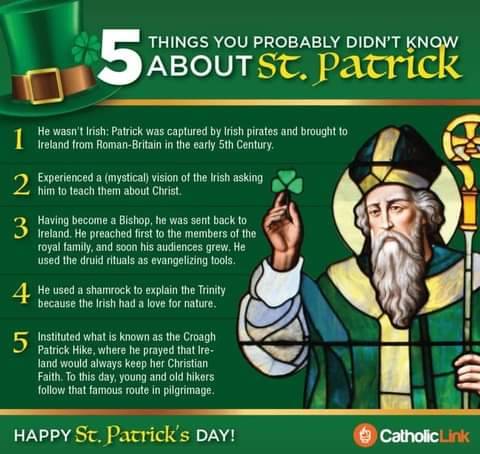
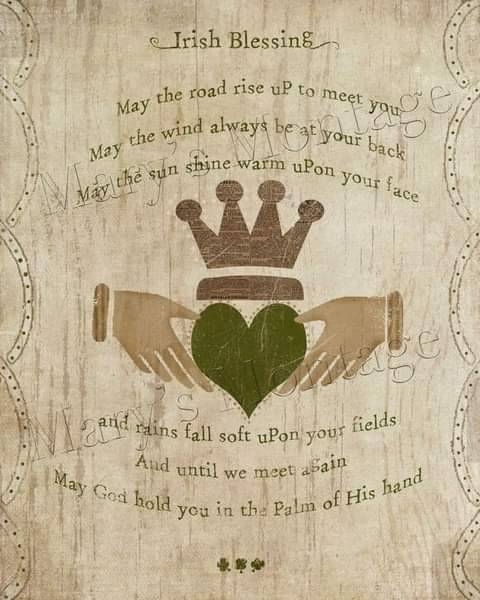

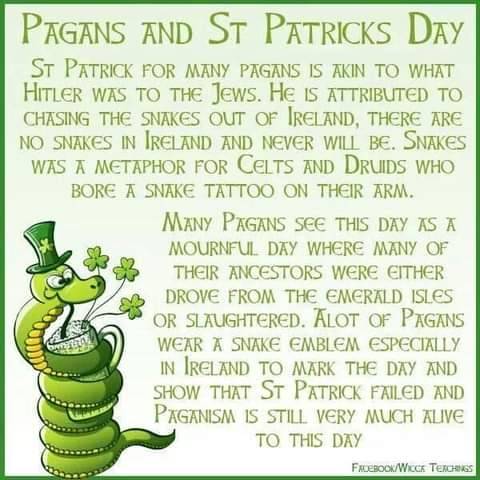
Saint Patrick is celebrated and honored on this day, because today was the day of his death; but he is also revered as the Patron saint of Ireland - and a feast day was created in memoriam of his arrival to bringing Christianity to Ireland.
For pagans... this is a very touchy subject... just like Valentine's Day. Pagens call it: All Snakes Day. Now, the legend says St. Patrick drove all serpents to slither away into the sea thus banishing snakes from Ireland. But the emerald aisle never was occupied by snakes. It is metaphor for The Druids who practiced the old ways and the old magic. Almost all Druids had snake tattoos in blue woad on their wrists and arms.
Now I'm not telling you this to say never celebrate Saint Patrick's Day ever again. I'm just bringing a little light into history and there's no reason why we can't honor both. Besides we have Americanized every holiday, so much so, that it's just something to celebrate. With our green beer and green eggs and ham and green Bagels, and of course corned beef and potatoes. I wish you a happy Saint Patrick's Day, be safe, and get a designated driver! 🌈💚🐍☘
1 note
·
View note
Text
TWA pygmy people were the first settlers of Ireland. The TWA wore a Uraeus, a particular hat showing a snake image which is also found on the heads of the images of the Kings and Queens of ancient Egypt. Thus St. Patrick is apparently celebrated by the Catholic Church for his work in the mass slaughter of the TWA throughout Northern Ireland.
Scottish historian David Mac Ritchie, and the British antiquarian Godfrey Higgins, have done exhaustive research and brought many facts to our knowledge. Tacitus, Pliny, Claudian and other writers have described the Blacks they encountered in the British Isles as “Black as Ethiopians,” “Cum Nigris Gentibus,” “nimble-footed blackamoors,” and so on. From all indications, the ancient dwellers of the British Isles and Ireland, like the Kymry (one of the names given to the earliest inhabitants, from whom the Picts and Scots descended), were Blacks. David Mac Ritchie has provided substantial evidence in his two-volume work, Ancient and Modern Britons that the Picts, as well as the ancient Danes, were Blacks. The Partholans, Formorians, Nemeds, Firbolgs, Tuatha De Danann, Milesians of Ireland and the Picts of Northern Scotland were all Blacks. The Firbolgs (believed to be a section of the Nemeds) are believed to be so-called pygmies or the Twa. They are the dwarfs, dark elves or leprechauns in Irish History. St. Patrick's Day, which is celebrated worldwide on March 17, honors St. Patrick, the Christian missionary who supposedly rid Ireland of snakes during the fifth century A.D.
According to legend, the patron saint of Ireland chased the slithering reptiles into the sea after they began attacking him during a 40-day fast he undertook on top of a hill. But snakes were certainly not chased out of Ireland by St. Patrick, who had nothing to do with Ireland's snake-free status. Why would a man be canonized {declared to be a saint} just because he supposedly got rid of all the snakes in Ireland? Monaghan, who has trawled through vast collections of fossil and other records of Irish animals, has found no evidence of snakes ever existing in Ireland. "At no time has there ever been any suggestion of snakes in Ireland.
[There was] nothing for St. Patrick to banish," Monaghan said. Snakes likely couldn't reach Ireland. Most scientists point to the most recent Ice Age, which kept the island too cold for reptiles until it ended 10,000 years ago. After the Ice Age, surrounding seas may have kept snakes from colonizing the Emerald Isle. Once the ice caps and woolly mammoths retreated northward, snakes returned to northern and western Europe, spreading as far as the Arctic Circle. But snakes have not existed in Ireland for thousands of years.
Britain, which had a land bridge to mainland Europe until about 6,500 years ago, was colonized by three snake species: the venomous adder, the grass snake, and the smooth snake.Animals that reached Ireland before the sea became an impassable barrier included brown bears, wild boars, and lynx—but "snakes never made it," he said. "Snake populations are slow to colonize new areas," Monaghan added.Mark Ryan, director of the Louisiana Poison Center at the Louisiana State University Health Sciences Center in Shreveport, said in 2008 that the timing wasn't right for the sensitive, cold-blooded reptiles to expand their range. "There are no snakes in Ireland for the simple reason they couldn't get there because the climate wasn't favorable for them to be there," he said. Other reptiles didn't make it either, except for one: the common or viviparous lizard.
Ireland's only native reptile, the species must have arrived within the last 10,000 years, according to Monaghan. The Twa journeyed to Northern Ireland very early in its conception prior to the influence of the Roman Catholic Church & had a cultural, technological, & philosophical impact on a people there known as the Druids. One of the cultural influences the Druids got from the Twa was the fact that they wore a fez or head cover that depicted the African symbol known is a Uraeus, which is the same snake image you see worn by the Kings & Queens in ancient Kemet {Egypt}. To Twa, some of the names for our people include; Naga, Nagar and Negus, which means loosely “serpent people” or “people of the serpent”. The name is also synonymous with Pharaohs and Kings. In many African cultures, the serpent is not a symbol of evil but one of eternal life, regeneration, power, protection, and wisdom.
The existence of the TWA also is reflected in many of the Irish legends that were passed down by the Druids to contemporary times. The story of the Leprechaun or a type of fairy that dressed in a green coat and who saved cold coins in a pot is a reflection of the diminutive people who were craftsmen in their time. It was said they had special knowledge of medicine, metallurgy, textile, and shoe-making which the Caucasians perceived as “magical.” The Roman Catholic Church seeing the practices of the Druids wanted to convert them, and if they couldn't, the would remove them & their beliefs as well along with the Twa who were still present in Northern Ireland at that time. St Patrick under the direction of Patrick who acted on behalf of the Catholic Church.
Author David MacRitchie, in his book Ancient and Modern Britons, wrote: “that the wild tribes of Ireland were black men is hinted by the fact that ‘a wild Irishman’ is in Gaelic ‘a black Irishman (Dubh Eireannach).” The word Dubh in Gaelic means Black. Was given an order to set up Roman Catholic Churches all over Northern Ireland, and in the process, convert or remove the Druid & Twa influence. He killed countless numbers of Druids & the Twa in the name of Father, the Son, & the Holy Spirit.
He was made a saint because he removed the snakes from Northern Ireland, it's really referring to the Uraeus head garment worn by the Druids & the Twa. And the leprechaun myth comes from the short Black men that were murdered all in the name of religion.

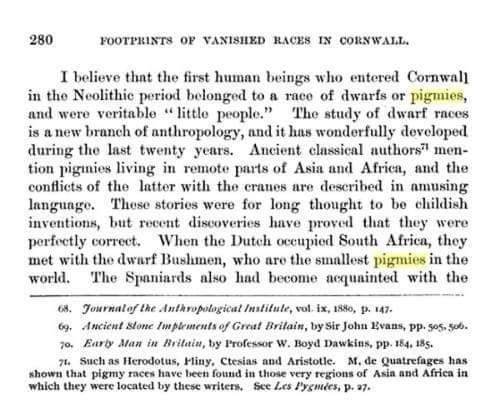

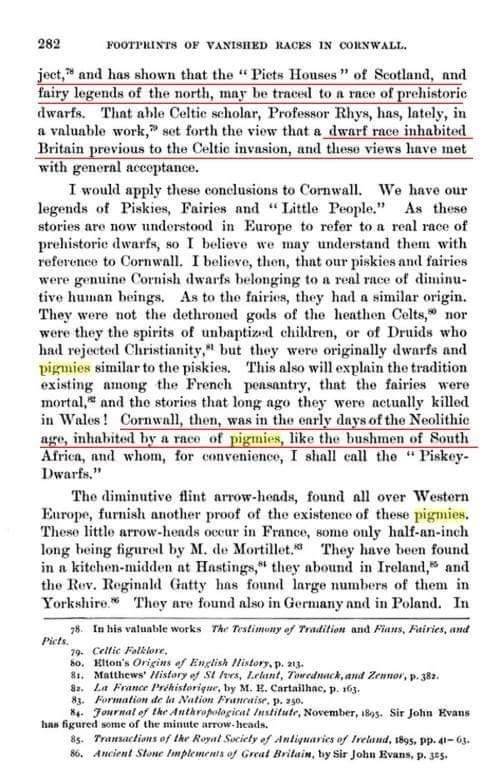
22 notes
·
View notes
Link
I wrote a tale called Every Thom, Dick, and Harry Has a Story, told from the perspective of Rhodry in the World of Omphalos. I’d felt very guilty about celebrating St. Patrick’s Day since I’d been told the cause was St. Patrick driving the snakes or the pagans out of Ireland. Either cause wasn’t a cause for celebration for me, not that I ever celebrated St. Patrick’s Day for those reasons. It was about having a Guinness and listening to Celtic music. For my husband, it’s an excuse to have corned beef and cabbage. I decided to write a story, sort my feelings out, do a little research on St. Patrick. Turns out most of legend wasn’t actually his, got mixed up with other saints, and I couldn’t find anything about anyone being driven out of Ireland. The only known fact about St. Patrick was that he was kidnapped by pirates. I decided to make my story about tall tales, a character named Padraig. Thom, Dick, and Harry (Dick and Harry being women) each had a story about Padraig and an opponent known as the Serpent, sometimes a serpent entity, sometimes a priestess. In Harry’s story, Padraig gets into a drinking contest with the Serpent after seducing all the pirates...I had a lot of fun coming up with four different legends for this character, told from Thom, Dick, Harry, and Rhodry’s perspectives. I wrote this story for a specific publication challenge. It was rejected. I tucked it away and had almost forgotten it...
1 note
·
View note
Text
St. Patrick & Ireland
Obviously, I was inspired with St. Patrick’s Day being yesterday, so I’ve decided to post about the wormhole of Irish folklore that I went down in my spare time yesterday.
Without further ado--here’s what I learned about St. Patrick:
As far as Sainthood goes, he IS an official Saint of Ireland. Little is known about the actual year of birth for Patrick, and there’s even debate on when he died. What we can ascertain from his writings is that he existed sometime in the second half of the 5th century meaning, around 450AD...ish. We know this because he made references in his writings to the, “heathen Franks,” meaning, unbaptized. We can date the Frankish baptism back to 496AD, so we can reasonably say that he was born sometime before that date, and was old enough to know that they were unbaptized up until that point. Patrick was born into a Romanized family that resided in Britain--meaning they were, at that time, citizens of the Roman Empire. He was kidnapped at some point by Irish raiders and sold into slavery. Since his father was a deacon, he at this point, leaned heavily on his religious upbringing to carry him through these troubling times. He eventually escaped, reunited with his family, and then supposedly paid a short visit to the Continent (which is the continental Europe, not including Britain or Ireland which are islands).
He is best known for his work the Confessio where he wrote, in a diary style format, a personal account of his life. In one passage, he mentions someone called Victoricus delivering a letter, The Voice of the Irish, that encouraged him to return to Ireland. After some hesitation at the state of his educational qualifications, he eventually conceded and returned to Ireland to start his new career baptizing, converting, and journeying far and wide to do the Lord’s work.
To sum up, he was an old school missionary that was converting pagans in Ireland to Christianity. He claims that he was the first person to Evangelize “heathen” Ireland, but it was more likely the work of Palladius, a bishop sent by Pope Celestine I to baptize the Franks en masse. However unlikely his own claims are, he had regardless achieved a legendary status by the 7th century. Some commonly associated legends include driving all of the snakes from Ireland into the sea where they met their demise, raising an alleged thirty-three people from the dead (some of whom had been dead for quite some time), praying for food for sailors passing through a desolate area when a herd of swine “appeared,” and last, but most common, the use of the shamrock as a religious teaching tool. He supposedly used the three leaves of the shamrock to represent the holy trinity(three leaves for the father, son, and holy spirit on one stalk).
There is lots of speculation as to why we associate the shamrock with St. Patrick’s Day. Basically the consensus is that it was a huge misconception about the importance of the plant to the Irish. Irish folklore is riddled with talks of druids, nature, earth, and magic. It is likely that most Irish held the earth and its many flora and fauna with extremely high regard, and perhaps even saw it as sacred. In my opinion, this is why using the shamrock was an extremely effective tool in rousing the interests of the common people, and inspiring pagan believers into Christian practices. The next part of the association comes from the scattered tribes of Ireland and the common observations of outsiders in their normal hunting and gathering practices. Many writers describe the eating habits of the “wild Irish” as having contained shamrocks and clovers (which I have learned are NOT, in fact, interchangeable). Shamrocks have three leaves or flowers, whereas clovers may contain 4 or more leaves. Regardless, neither were known to have been a main source of sustenance, although, they were known to forage and eat quite a wide variety of plants including a similarly looking plant called wood sorrel which is almost unmistakably a shamrock to the untrained eye.
To make a long story of historical telephone short, it was written that these “wild Irish” ate shamrocks, a shamrock was already associated with St. Patrick who had used it to convert pagans, and like humans are likely to do, we saw a shamrock and said that goes with Ireland in our minds and it was forever associated with Ireland. So much so, that it is actually the national symbol of Ireland and is still worn on the lapels of Irish members of the Royal Irish Regiment of the British Armed Forces every St. Patrick’s Day, and fresh shamrocks are exported to wherever the regiment may be stationed throughout the world. The Prime Minister of Ireland, known as the Taoiseach or “chieftan,” also traditionally presents the President of the United States with a unique Waterford crystal bowl shaped like a shamrock and filled fresh shamrocks on every St. Patrick’s Day.
It’s a national day of celebration in Ireland and the best way to celebrate is by “drowning the shamrock,” a traditional salute to Ireland, St. Patrick, and to those present by placing a shamrock at the bottom of a cup and then filling it with whiskey, cider, or beer (be it green or not), and then drinking to a toast. The shamrock is then consumed or tossed over the shoulder for luck. This tradition may be where we associated the shamrock with luck and the Irish people as having luck on their side. If you’ve ever heard the phrase, “the luck of the Irish,” you’ll know that there’s something uncanny about their good fortune, but the phrase actually refers to a time during the 19th century called the Gold Rush. It’s commonly believed that a lot of successful miners were of Irish descent and thus the phrase stuck. Perhaps this is why we also associate the image of the folk character, the leprechaun to this holiday as well.
Leprechauns were known to Irish folklore as fairies that were tinkerers or craftsman and made shoes. One could determine the presence of a leprechaun from the sound of hammering in one’s home or place of business. These creatures were typically distinguished by an old lopsided (often worn or ragged) leather hat, and were small and sometimes invisible. If you were cunning enough to capture a leprechaun, you could threaten it with bodily harm or violence and perhaps convince it to lead you to it’s crock of gold. The catch is that you have to keep your eyes on the little guy the whole time, so often enough these cunning creatures would convince their captors to glance away and then disappear forever without revealing the location of their coveted gold. As you can see, it’s not a far reach to associate a successful gold miner of Irish descent with a creature of legend and mystery. This leads into a much deeper, darker, and less fun side of America’s history and the treatment of its immigrants of various descent, and for this piece, I don’t think we’ll go there. COVID-19 has done enough damage and deep, dark, less fun seems to be its operational slogan.
Stay safe out there, folks!
#history#itshistoryyall#irish history#stpattysday#stpatricksday#ireland#luckoftheirish#shamrocks#folk history#covid-19#corona virus#history lesson#today in history#yesterday in history#late post#green#lucky#christianity#pagan#pagan beliefs#history of christianity#saints#patron saints#pope
11 notes
·
View notes
Text
Feeding snakes against the cult of St. Patrick by neopagans.
#Paganism #DruidCraft #Celtic I did not celebrate St. Patrick's Day for three different reasons, first, I'm not Irish, second, I'm not American, I'm Turkish-Hispanic, and third, I come from a polytheist family, but my family, especially my grandmother and my mother raised me with enormous respect for the pagan community, she said, it does not matter if they are pagans, neopagans, wiccans, druids, it does not matter even if they preach a new religion or are part of some sect founded in the next thirty years, while they venerate the ancient gods, those gods before Christianity, are our brothers, even when many of them throw stones at us, they are our brothers and we must remain united above all.
Saint Patrick, this supposed Saint is Ireland, whose stories I have read countless times and all seem to be in complete disagreement with each other, not to mention that many of these stories only take the old legends of Irish folklore and turn them into "miracles" around to the Saint He was not like they want to paint now all these "pagan missionaries" of the New Age, a "savior and pacifist pattern", was a Christian priest who enlisted in the ranks of the church to not have to be part of the family business during a terrible economic period where the Roman Empire was taking over all foreign businesses.
Everyone says that he released Ireland from the Serpents, the truth is that the island of Ireland unlike the islands of Scotland and England was never connected to the same tectonic plate, there was no terrestrial communication between one island and another, and it is about A cold island, there has been no historical or scientific evidence of snakes in Ireland for 15Mil years until our then. There is no other joke about it, there simply were no snakes when he arrived on the island.
The serpent was a symbol of pagan paganism in Ireland, paganism in Ireland fell in the fifth century when he lived this character, this "pseudo Saint" Catholic. The phrase "St. Patrick freed Ireland from the snakes" is extracted from a few letters that he left written where he communicated with the Church affirming that there were no pagans on the island, and in fact, if you check all the Catholic writings that you can find In any library or Museum of your Country, you can verify that pagans were always represented with the image of a snake, allusion to the Jewish cult where 'Samael' the snake that was possessed by Lilith (the first Woman before Eve) tempted Adam and Eve to eat the apple of the tree of knowledge, which opened their eyes and because of that, Yahweh condemned 'Samael' and took him out of the Garden of Eden condemning him to crawl for eternity so that he could never see his face in eternity.
If you want to have fun and go out with your friends dressed in green and disguised as an elf, you have another 364 days to do it, but not St. Patrick's Day, which should be considered a day of mourning for the pagan community, are the same as they fill their social networks with those empowerment memes under the same motto of "we are the children of those witches that you could not burn at the stake", they use that day to become pacific saints and pagan missionaries affirming "Saint Patrick was never against the pagans "and" he is not to blame for what happened ", but I think the opposite, when you see that a minority group is being discriminated against and you become part of the discriminating group, you become part of the problem, and even worse, as in this case, on the side murdered thousands of witches and pagans in the following ages.
The truth behind 'the great conversion' of the emerald island 'Ireland' and it is not necessary to read much about it since all the history books have taught us the same thing, between the 4th century and the 7th century of our era, is that those who were not converted to Christianity and did not accept to be baptized, were expelled from the island, burned alive, tortured or imprisoned, as was the case with many Celtic pagans and their druids.
When you celebrate Saint Patrick's Day you are ignoring and celebrating the tombs of the pagans and witches who for centuries have been burned, hanged, or (as it happened for centuries in South America) drowned in the sea where they were thrown with cloth bags full of stones to sink their bodies on the seabed.
Now many pagans, and from my point of view are correct, celebrate the day of the Serpent on the same day to protest, and the truth, my support is with them, with those who have not sold their beliefs to be part of the 'popular cult', is not that this in favor of keeping the hated towards the Catholic Church, but I am in favor of not forgetting and making fun of the past in this way so sickly and ridiculous.
The pagans and "neopagans" celebrating this day look as absurd as the new sects of neo-Nazis who deny the holocaust to victimize the others.
Here I have left you the reasons why you did not celebrate this day, because as my mother taught me 'forgive if you want to do
So please, if you consider yourself pagan, not famous this day.
#witchcraft#pagan#wicca#magick#witches#witch#WitchCraft#witches of tumblr#wiccan#wiccans of tumblr#wiccans#wiccans of facebook#wiccanstuff#pagans#paganism#paganist#pagans of tumblr#pagan wicca#pagan witch#hellenic pagan#celtic#druids#druidism#druidcraft#druidry#druid#ancient celts#ancient religion#ancient faith#ancient times
3 notes
·
View notes
Text
Get St Patrick's Day Off to a Green and Groovy Start
Pots of gold. Four leaf clovers. Lots of Guinness. Little leprechauns. Green clothes. Joyous shindigs with friends and family... St Patrick's Day or Paddys Day is one of the greatest Irish festivals, which commemorates the death of St. Patrick, the patron saint of Ireland, who was believed to have brought Christianity to the Irish. It's also supposed he drove the snakes from the country.
St Patrick’s Day Greetings Cards
St Patrick's Day is also marked with a public holiday in the Republic of Ireland, and across many parts of the world. But it's also a holiday, imbued with magic, fantasy and the belief that with a little luck, anything is possible.
As we know it, this merry day involves a great deal of alcohol. But where did this custom come from? As one old Irish legend would have it, St Patrick was served a measure of whisky that was by far less than full. So St Patrick took this chance to teach the stingy innkeeper a lesson. He warned the innkeeper that a monstrous devil lurked in his cellar, who fed on the dishonesty of the innkeeper. But in order to drive out the devil, he must amend his ways.
St Patricks Day Quotes
When St Patrick revisited the inn some time later, he found the owner generously filling the patrons' glasses to the brim. He returned to the cellar with the innkeeper, to find the devil thin and withered from the landlord's generosity, and promptly cast out the demon, announcing that from then on, everyone should have a drop of the 'hard stuff' on his feast day.
Most of you have probably heard of, or tried out 'Pota Phadraig' or 'Patrick's Pot' whereby the leaf of the shamrock plant is placed in the whisky before downing the shot. Saint Patrick told the people that the shamrock was like the idea of the Trinity - that in the one God, there are three divine beings: the Father, the Son and the Holy Spirit.
St Patrick Day falls on March 17th 2011, and those observing this occasion will have more luck keeping their Pot of Gold by shopping online for reasonably priced gifts that the whole family can enjoy! Top o' the morning to ye!
St Patricks Day Wishes
Spread the Irish spirit of St Patricks Day with everyone you love and get the merrymaking started in style by choosing a bottle of personalised whisky, featuring the name of your dear one, and even your own personal message. Or celebrate with a personalised bottle of wine, bubbly or vodka.
If they prefer a non-alcoholic beverage, how about an Irish Flag mug, decorated with their name and beverage choice? Have a tree planted for them in Northern Ireland by Tree Appeal, or if you fancy a quick getaway to the land of the leprechauns to celebrate the occasion, there are masses of options on offer.
Golf and spa lovers can rejuvenate on a Temple Spa & Golf break in Ireland's beautiful County Westmeath... Adrenaline junkies can experience a pure adrenaline rush as they take to the skies in a helicopter or Microlight aircraft. Those with a need for speed will experience off-roading, quad bike style, as they race around a tough track or rugged Irish terrain of woodland.
0 notes
Text
FROM A SAINT AND SNAKES IN IRELAND TO PARADES AND DRINKING GREEN BEER
Everyone is Irish today. It’s St. Patrick’s Day!
The wearin’ of the green. Even I am in green. I dug out an old green tee shirt and am wearing it as I write.
Think about it. Today’s title fits: From a Saint and Snakes in Ireland to Parades and Drinking Green Beer.
I am going to share some tidbits of information concerning St. Patrick and the holiday. Some you may know, or think you know. Others not and will be surprised.
St. Patrick was not Irish. If one goes way back, he has been described as Italian born as a Roman. Some say he is of English birth since when captured at 16 he was living in England. One thing is sure, he was not born in Ireland.
St. Patrick’s Day was not always a big party. Not even a parade. Initially considered a celebration. It was a Catholic feast day. The first largely public celebration occurred in Boston in 1737.
Note again, no parade involved. Merely a party of sorts.
Now for the real confusion.
Confusion arises in trying to accurately determine the date of the first parade and why March 17 is the day we celebrate St. Patrick’s Day.
Repeating myself, the first celebration was in 1737.
The date of the first parade claimed by a number of communities. St. Augustine, Florida 1601. New York City 1762. New York City again 1776.
March 17 is also significant for other claims. His date of capture 432 A.D. His date of death 461 A.D.
All of the preceding have been claimed as having occurred on March 17 and such is the reason St. Patrick’s Day is celebrated on March 17. Obviously no one is sure why.
St. Patrick, the shamrock and the Irish are interrelated. Legend has it that Saint Patrick used the shamrock to describe the idea of God as a Holy Trinity. Three leaves on a normal shamrock. God consisting of Three Persons.
St. Patrick wore blue. Never green. People started cloaking images of him in green in the 19th century. For purposes of celebration and to commemorate St. Patrick’s use of the shamrock.
Snakes were never driven out of Ireland by St. Patrick or anyone else. There never were any snakes in Ireland. The snakes are actually a metaphor for the pagans St. Patrick drove out of Ireland.
There are more Irish in the U.S. today than in Ireland. Significantly more. The present U.S. population of those of Irish descent is 35 million. Ireland’s population is only 4 million.
The river running through Chicago is always green for St. Patrick’s day. Huge amounts of green coloring are hosed into the water. The greening of the river began in 1962.
I watched it being done yesterday in Chicago this morning on TV. Relatively large tug type vessel. Celebrants on board already partying one day early.
Corned beef and cabbage is a popular Irish tradition. Each year it is estimated 26 billion pounds of beef and 2 billion pounds of cabbage will be consumed worldwide. Also consumed worldwide will be 13 million pints of Guinness beer.
The one source considered accurate re Saint Patrick’s life is a work by St. Patrick himself wrote in the last years of his life. Confessio.
Normally I would be running around Key West tonight looking for an empty table to have corned beef and cabbage. Donna, Terri and I become a three some for dinner. Not tonight, of course. I still do not have my third shot and even if I did. there are too many virus carrying visitors in town.
Every restaurant will have excellent corned beef and cabbage. I happen to love corned beef. Especially when fatty. Last year, I began frequenting Shanna Key on Flagler one night a week. A true Irish restaurant, Shanna Key has corned beef and cabbage on the menu every night. I recommend it.
Enjoy your St. Patrick’s Day. I will be spending my evening home in front of the TV set probably eating a ham and cheese sandwich. I might sneak a Beefeater in.
FROM A SAINT AND SNAKES IN IRELAND TO PARADES AND DRINKING GREEN BEER was originally published on Key West Lou
0 notes
Text
Where is New Zealand located ?
>Who has forgotten the rain jacket, notices this best of all already during the stopover in Hong Kong and goes shopping there quickly. The cost of living calculator for emigrants on enz.org estimates at least 200 NZ$ per week for food costs per family with two children - and it calls this "frugal". If you want to drink a bottle of wine from time to time or dine in the take-away, you should rather calculate 320 NZ$ per week.
When does winter begin in New Zealand?
St. Patrick, who missionized the Irish Celts in the 5th century, did not have to drive the snakes from the island - there were none even then. The reason for this is the geographical isolation of Ireland.
Search
The fertile, highly productive soils allowed agriculture to flourish and access to two large natural ports facilitated fishing. In addition, the fortified settlements on the volcanic hills and the protected position on the isthmus made defence easy. is under the influence of a subtropical-oceanic climate. Temperature fluctuations throughout the year are small. The climate is characterized by long warm, humid summers and cooler, rather humid winters.

The maximum penalty for speeding is 1'000 NZD. New Zealand has a reputation for good and safe roads.
They have got back their Maoritanga (way of life) and proudly show their tattoos, live openly their traditions and tell their myths and legends.
Auckland and Wellington on the North Island and Christchurch on the South Island are the biggest cities in New Zealand.
Car rental and campervans are now the cheapest.almost the entire west coast of the South Island is covered by dense (endemic) temperate rainforest, the Southern Alps are part of the alpine vegetation. The hours of sunshine have increased to seven hours per day.
The continent Australia
The seven continents each take up less than one-tenth of the earth's surface. The area of the largest (Asia) and the smallest continent (Australia/Oceania) differ by a factor of five.
Read more about campervan hire New Zealand here. To the question "To which continent does New Zealand belong? This is due to the fact that both countries are closely connected historically and politically. Another interesting museum is the Auckland War Memorial Museum, located in the Auckland Domain Park, which houses collections on the history and culture of MÄori and on New Zealand's nature. One gets an insight into the still existing fauna of the country in the zoo of the city. Your own weather forecast is probably only reliable for 15 minutes. The tree nettle (Urtica ferox) does the same thing as all nettles and sheds stinging hairs when touched, which bring the poison into the victim's skin.
0 notes
Text
weather & climate New Zealand: climate table, temperatures and best travel time
The Deadly: "Tree Tutu" and "Ongaonga" alias Tree Nettles
What spiders are there in New Zealand?
German nationals do not require a visa for New Zealand if they are staying as tourists for 3 months in New Zealand. A passport that is still valid for at least three months is required for entry into New Zealand.
>/div>>/div> However, the insurance is only valid for a certain length of trip, many people do not pay attention to this. We were on the road for 2 months and thus over the given travel length - I think it was 50 days - and then booked our insurance through TUI and their Visacard Gold extra. read for the first time on your site, which I find very clear, extremely informative and "lifelike". But nevertheless the flight will cost us about € per adult. Our plan is to book a return flight from Germany to Asia (probably to Singapore, back via Bangkok). Then we will acclimatize for a few days in Asia and then we will continue with a budget airline, or whatever is cheaper.
When does winter begin in New Zealand?
St. Patrick, who missionized the Irish Celts in the 5th century, did not have to drive the snakes away from the island - there were none even then. The reason for this is the geographical isolation of Ireland.
The city consists to a large extent of suburbs with predominantly flat buildings. Auckland is the fastest growing city in the country. The roadways added on both sides of the bridge in 1969 due to extremely heavy traffic became dilapidated over time and were repaired for the time being, but will have to be completely renewed in the future. Until then, there are plans to relieve the structure, which suffers from chronic congestion, either by building another bridge or an underground connection. The main reasons for settling in this area were the good possibilities for food supply and the strategic advantages compared to other settlement areas.
What sounds like a tour operator, is in fact one of New Zealand's musical superstars.
While the main islands of the archipelago are never wider than 450 km in east-west direction, they extend along the main axis in north-eastern direction over 1600 km.
The names of the continents are all female in the original Latin form and end uniformly at -a.
So a male can be 6m and more long.
With the warm weather and the beginning of the big holidays in New Zealand, the prices for hotels or rental cars are also increasing significantly.
According to another legend, Kupe from the Polynesian Hawaiki discovered the island of New Zealand in the year 950 BC.
Hawke's Bay is New Zealand's largest growing area with the largest range of products. More than half of New Zealand's apples are grown here and 40% of the country's "summer fruits" come from here. As far as I understand it, the kiwi dollar is a currency that is often used for speculation and is therefore extremely volatile. Before paying large sums of money, you should definitely check the exchange rate. After natural disasters such as major earthquakes, the Kiwi Dollar tends to plummet, and your money is suddenly worth much less. I wrote down a few words in German and the same words that the children and people in this country say in English.

Read more about campervan hire New Zealand here.
0 notes
Text
Erin Go Bragh: How St. Patrick's Day Celebrations Were Shaped by Marketing

In Boston, just across the river from HubSpot’s headquarters, St. Patrick’s Day is kind of a big deal. There’s a parade. There’s a special breakfast for the who’s-who of local government. There are green bagels. And there’s a lot of beer.
We like to think of that as a very traditionally Bostonian way of celebrating St. Patrick’s Day. And we’re not alone -- in Chicago, for example, they dye the river green. But we’ve got news. That word, “tradition”? We hate to break it to you, but today’s celebrations of St. Patrick’s Day are, well, far from traditional.
And like so many other holidays, the modern perspective and observance of St. Patrick’s Day was shaped in some part by -- you guessed it -- marketing. But what did it used to look like, and how did it get to where it is today?

Grab your four-leaf clover, because you’re in luck. (Sorry, we couldn’t help ourselves.) We’re taking you on a trip back in time to figure out just where St. Patrick’s Day began.
How St. Patrick's Day Celebrations Were Shaped by Marketing
Who Was Saint Patrick, and Why Do We Celebrate Him?

Source: History.com
The Man
To really trace the roots of St. Patrick’s Day, it’s important to understand its name. Yes, it’s named for a person -- Saint Patrick himself -- who actually wasn’t even of Irish descent. According to History.com, he was actually born in 390 A.D., in Britain to a Christian deacon father. It’s rumored that he assumed that role for its tax incentives, and not for religious reasons. In fact, some speculate that Saint Patrick wasn’t raised with much religion at all.
Interestingly enough, it was being kidnapped in his teen years and held captive by Irish raiders that began Saint Patrick’s journey to, well, sainthood. Much of that captivity was spent in isolation from other people, which allegedly caused Patrick to turn to spiritual thoughts for guidance and comfort. After six years as a prisoner, he escaped back to Britain, and eventually studied to become a priest.
After he was ordained, he was sent on a mission back to Ireland to begin spreading and converting the population to Christianity. And according to National Geographic, it didn’t go so well -- “he was constantly beaten by thugs, harassed by the Irish royalty, and admonished by his British superiors,” and he was “largely forgotten” after his death in 461 A.D., which is estimated to have taken place on March 17, the day observed as St. Patrick’s Day.
The Myth
But later, people started to create folklore around Saint Patrick. It’s not clear when these legends came to fruition, but you might be familiar with some of them -- tales of him banishing all snakes from Ireland, for example, which are the stories that eventually led to him being “honored as the patron saint of Ireland” -- hence the name, Saint Patrick.
Still, the celebrations of him within that particular nation remained pretty low-key until the 20th century, prior to which March 17th was mostly observed with a mention of it by priests, and a feast enjoyed by families. Plus, there remains conflicting information about his life and the exact dates of its major events.
In fact, the celebrations really began right here -- in Boston.
What the Earliest Celebrations Looked Like
Coming to America
According to Time, the inaugural celebration of St. Patrick’s Day took place in 1737, in the form of “a group of elite Irish men” in Boston gathering for a dinner dedicated to “the Irish saint,” who one might assume was Patrick himself. Less than 30 years later, parades began in New York, with Irish-American members of the U.S. military marching to honor Saint Patrick “with Fifes and Drums.”
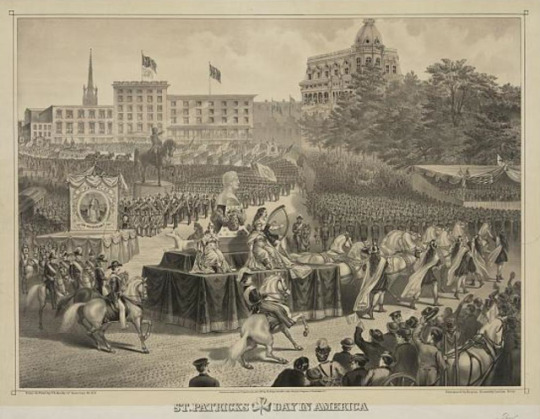
Source: Ephemeral New York
Both of these events have led many to speculate that how we view St. Patrick’s Day today was largely an American invention, as many of the traditions we still continue to honor -- including the New York City parade, which has grown by leaps and bounds in the past 251 years -- were started by Irish-American immigrants. And as Irish immigration increased exponentially during the 1800s, the celebrations grew in kind, in large part to combat stereotypes that this incoming population was “drunken, violent, criminalized, and diseased.”
Irish-Americans wanted a way to illustrate that they were wholesome people -- that they paid tribute to their natively religious roots with an observation of the patron saint, but that they also embraced life in America, by creating these traditions on new land. And that population was the most concentrated in Boston, Chicago, and New York -- which might be why we today see the grandest celebrations in those cities. That began when Irish-Americans continued to face opposition by others, despite the aforementioned best efforts. The parades got bigger and occupied less localized venues, sending the message, "we’re 'not going anywhere.'"
Meanwhile, in Ireland …
Eventually, around the 1920s, Ireland began to observe St. Patrick’s Day celebrations beyond church mentions and family meals. Not entirely unlike New York, it started with military parades in Dublin, but they weren’t exactly festive -- “the day was rather somber,” writes Mike Cronin, with “mass in the morning [and] the military parade at noon.” And, until the 1960s, there was no drinking -- before then, bars in Ireland were closed on St. Patrick’s Day.
But in that country, at least, the holiday saw a real turning point in 1996, with the very first instance of the St. Patrick’s Festival in Dublin: A four-to-five-day festival (which began as just one day) of music, parades, and other revelry. This year’s edition of the festival just kicked off yesterday and, today, brands across numerous nations -- Ireland and the U.S. alike -- are capitalizing on the celebration.

Source: St. Patrick’s Festival
We’ll get to that in a bit. First, let’s look at how some other St. Patrick’s Day traditions got started.
Why Green?
It all began with a song, “The Wearing of the Green.” It dates back to 1798, when it was said to be written as a tribute to Irish Rebellion fighters, and has been repurposed many times since. The phrase in this post's title, too, has ties to Irish fighters -- "Erin Go Bragh," which is traditionally spelled "Éirinn go Brách," means "Ireland forever," or Ireland "till doomsday."
The most notable version of "The Wearing of the Green" is thought to be the one written and performed by Dion Boucicault in 1864 for the play Arragh na Pogue, or The Wicklow Wedding. And while there’s some controversy surrounding this theory, many believe that’s where the tradition of wearing (and consuming) all things green on St. Patrick’s Day is rooted -- though it’s an act of gross misinterpretation, since the lyrics were actually meant to encourage the wearing of a green shamrock, a symbol of the Holy Trinity. In reality, the original color association with St. Patrick’s Day was blue.
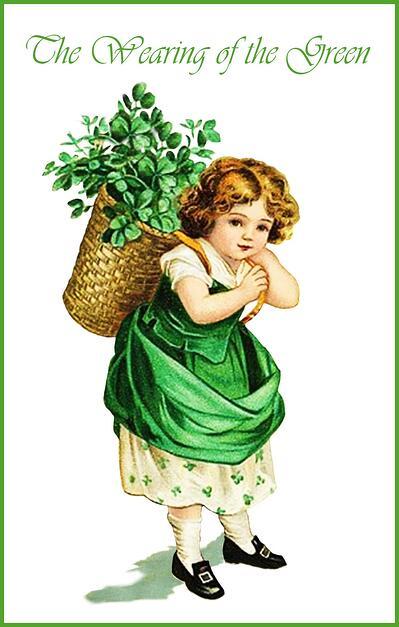
Source: Free Printable Greeting Cards
But what of that shamrock, yet another item that’s come to be so strongly associated with contemporary interpretations of St. Patrick’s Day? Well, that goes back, in part, to “The Wearing of the Green” lyrics. Have a look:
She's the most distressful country that ever yet was seen
For they're hanging men and women there for Wearing of the Green.”
Those lyrics actually allude to the fact that, during the Irish Rebellion, wearing a shamrock was an offense punishable by death -- and doing so came to be seen as a brave act of rebellion and loyalty to one’s Irish roots.
It could be why, today, wearing green on March 17th -- often adorned with shamrock shapes -- is loosely seen as an act of pride for all things Irish. In fact, you may have heard the phrase, “Everyone is Irish on St. Patrick's Day,” which has been largely perpetuated by high-profile Irish brands, like Guinness.
That’s one particularly outstanding example of how St. Patrick’s Day is now highly commercial -- it’s not just American brands that are leveraging it for marketing purposes. And believe it or not, there are many indicators that it began with this accidental tradition of “the wearing of the green.”
When It Started to Get Commercial
It’s the Shamrocks, Again
There were several pivotal moments in the history of St. Patrick’s Day that could be pointed to as the beginning of its commercialization -- events like the first St. Patrick’s Festival in Dublin, or the first parade in the U.S. Indeed, it seems that the commercialization did begin stateside in 1952, when Irish ambassador John Joseph Hearne delivered a box of shamrocks intended for then-President Harry Truman. It’s since become an annual tradition.
But it wasn’t just the start of tradition. What used to be a symbol of Irish pride and rebellion was now being gifted to U.S. officials from Irish ones. It signaled the same efforts that Irish immigrants were trying to make when their small, localized St. Patrick’s Day celebrations first began: Honoring native traditions, while also embracing the U.S. by sharing them. It was an effort to establish and strengthen “pro-Western credentials with Washington” -- a city where, at the time, there was little observance of St. Patrick’s Day -- said Michael Kennedy, executive editor of Documents on Irish Foreign Policy in an interview with CNN.
In a way, it could be said that Americans embraced this Irish tradition in return -- but not without putting its own commercial spin on things. The same year as that unintentionally monumental shamrock delivery, Pan American Airlines promoted its first direct flight from Shannon, Ireland to New York by flying 100,000 native shamrocks to be handed out to those marching in the New York parade.

Source: Newspapers.com
In other words, at that point, the shamrock had made its way to the U.S., and businesses and consumers alike couldn’t get enough of it. "The marketing of 'real' shamrock was...part of the commercialization of St. Patrick's Day," writes Cronin in his book The Wearing of the Green. "More frequently, the image or symbol of the shamrock was employed artistically -- adorning souvenirs, advertisements, decorations, greeting cards and clothing."
Most of all, the celebration of St. Patrick’s Day in the U.S. now extended far beyond the Irish-American population. With the shamrock’s permeation into popular culture, non-Irish individuals also began to take part in the holiday’s observance, adapting it as their own until it got to where it is today -- green rivers, green beer, and a lot of shiny green accessories. As we said, and as is often claimed: “Everyone is Irish on St. Patrick's Day.”
Today's St. Patrick's Day Celebration
So, what are your plans for St. Patrick’s Day? Does it involve any of the aforementioned revelry and/or accompanying green adornments? Will you be feasting on corned beef and cabbage -- a dish largely unconsumed in Ireland? Now you know how we got here.
It’s been quite a few years since I’ve donned my own glittery, shamrock-shaped earrings, or worn beads a shade of metallic green while partaking in a March 17th pub crawl. But now I’m aware that none of this has to do with the person for whom the holiday is named: Saint Patrick. And as a marketer, I can’t be too angry about it -- after all, many holidays in the U.S. have evolved in a similarly commercial fashion. Just last month, we discussed how that took place with Valentine’s Day, which was also originally established in observance of a saint.
But we will ask that, as you go forth and consume a green milkshake today, to at least be aware of the history that made it possible. Erin Go Bragh -- and as the saying goes, may you have a world of wishes at your command.
How does your brand observe St. Patrick’s Day? Let us know in the comments.


from HubSpot Marketing Blog https://blog.hubspot.com/marketing/st-patricks-day-marketing
0 notes
Text




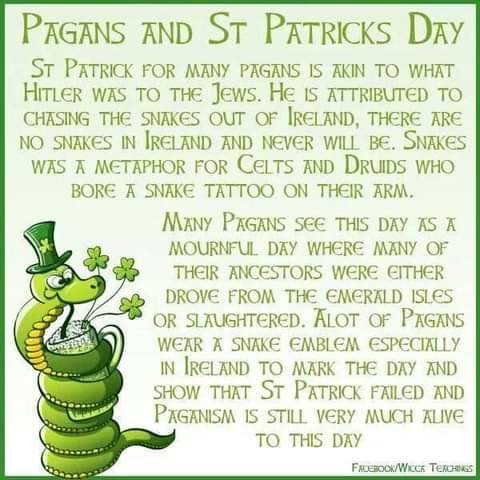
Saint Patrick is celebrated and honored on this day, because today was the day of his death; but he is also revered as the Patron saint of Ireland - and a feast day was created in memoriam of his arrival to bringing Christianity to Ireland.
For pagans... this is a very touchy subject... just like Valentine's Day. Pagens call it: All Snakes Day. Now, the legend says St. Patrick drove all serpents to slither away into the sea thus banishing snakes from Ireland. But the emerald aisle never was occupied by snakes. It is metaphor for The Druids who practiced the old ways and the old magic. Almost all Druids had snake tattoos in blue woad on their wrists and arms.
Now I'm not telling you this to say never celebrate Saint Patrick's Day ever again. I'm just bringing a little light into history and there's no reason why we can't honor both. Besides we have Americanized every holiday, so much so, that it's just something to celebrate. With our green beer and green eggs and ham and green Bagels, and of course corned beef and potatoes. I wish you a happy Saint Patrick's Day, be safe, and get a designated driver! 🌈💚🐍☘
0 notes
Text
It’s a Leap Year Why Women Are Allowed to Propose on February 29 added to Google Docs
It’s a Leap Year Why Women Are Allowed to Propose on February 29
It’s a Leap Year in 2020, and if you remember the 2010 movie of the same name starring Amy Adams, you might remember that, according to Irish tradition, women are allowed to propose on February 29th for good luck. So, where did this movie premise and Irish folklore come from? Irish legend has it that it started with a fifth-century Irish nun named St. Brigid of Kildare. Apparently, St. Brigid was listening to a ton of single women who were complaining that their suitors were too shy to get down on one knee. The wait to get married was too long, and these enamoured and impatient women couldn’t do anything about it! Pretty relatable, right? Who hasn’t wished that their partner of three-plus years would finally make it “official”? Answer: everyone. Anyway, wanting to help these ladies out, St. Brigid went to St. Patrick, the patron of Ireland (and, yes, the guy responsible for St. Patrick’s Day), and requested a favor. She wanted him to grant permission to these frustrated women the ability to propose to the men in their lives. Initially, St. Patrick said yes, but with a caveat: they could propose to their suitors but only once every seven years. Well, St. Brigid thought that was too long a wait. Imagine having to wait seven years to be allowed to take some action forward with your relationship? No, thanks! Instead, St. Brigid suggested the option of proposing every Leap Year, meaning every four years. St. Patrick saw her point, or at least agreed to her wishes, and then allowed proposals every four years. Now, here comes a major plot twist. Just when St. Patrick gave his permission for women to propose to their partner, legend has it that’s when St. Brigid got down on one knee and asked for St. Patrick’s hand in marriage! That’s probably why she wanted him to change his offer, right? Anyway, unfortunately, St. Patrick rejected St. Brigid’s offer of marriage (he was probably busy doing a lot of important stuff, like kicking out snakes from the country) so instead, he kissed her on the cheek and offered her a silk gown to soften the blow. Ugh. This is why the Leap Year tradition dictates that if a man is to reject the offer of proposal, he must give her a silk gown instead. Because, as we know, nothing mends a broken heart faster than a fancy set of pajamas! The Irish folklore proved so intriguing that it was adopted by the Scots back in 1288 when Queen Margaret allegedly enacted a law that allowed women to propose on February 29th. Talk about making it official. There was one catch, though: the women proposing must wear a red petticoat while doing so. There isn’t really a reason given for this except that maybe Queen Margaret liked her women to look stylish. Any Scottish man who declined the proposal on this day would have to pay a fine, which might include anything from a kiss to payment for a silk dress or a pair of gloves. Perhaps Queen Margaret, the sartorial fan she was, really did believe that receiving a pair of gloves would make the embarrassment go away. If this all sounds a little, well, phoney, you’re not wrong. Historians have often debated the merits of the folklore, insisting that, according to the timeline of the aforementioned events, it was impossible any of this could have taken place. For instance, Queen Margaret would have been just five years old when the Leap Year was proposed (pun intended) and apparently St. Brigid was just nine or 10 years old when St. Patrick died in 461 A.D. so their friendship, not to mention any romance between them, would’ve been unlikely. Regardless of whether the Irish legend is true or not, you have to admit that it makes for a pretty romantic gesture, and a unique love story. So if you’re a woman who wants to marry your partner, then use the magic of this Leap Year day and propose to your man. May the luck of the Irish be with you!
via Weddingbee https://www.weddingbee.com/engagement/its-a-leap-year-why-women-are-allowed-to-propose-on-february-29/ Nhà hàng Hương Sen chuyên buffet hải sản cao cấp✅ Tổ chức tiệc cưới✅ Hội nghị, hội thảo✅ Tiệc lưu ��ộng✅ Sự kiện mang tầm cỡ quốc gia 52 Phố Miếu Đầm, Mễ Trì, Nam Từ Liêm, Hà Nội http://huongsen.vn/ 0904988999 http://huongsen.vn/to-chuc-tiec-hoi-nghi/ https://trello.com/userhuongsen
Created February 28, 2020 at 09:08PM
/huong sen
View Google Doc Nhà hàng Hương Sen chuyên buffet hải sản cao cấp✅ Tổ chức tiệc cưới✅ Hội nghị, hội thảo✅ Tiệc lưu động✅ Sự kiện mang tầm cỡ quốc gia 52 Phố Miếu Đầm, Mễ Trì, Nam Từ Liêm, Hà Nội http://huongsen.vn/ 0904988999 http://huongsen.vn/to-chuc-tiec-hoi-nghi/ https://drive.google.com/drive/folders/1xa6sRugRZk4MDSyctcqusGYBv1lXYkrF
0 notes
Text
ERIN GO BRAGH
WF THOUGHTS (3/17/19).
It's 2:00 p.m. on St. Patrick's Day. Right now many of my readers are not able to read. A hearty "Sasta La Fheile Padraig" to y'all.
I'm as Irish as the Blarney Stone, and I enjoy Irish tales. To counterbalance all of the Irish yarns that are being told today, let me spread a little Irish truth.
First of all, St. Patrick was not Irish. He was not born in Ireland, and none of his ancestors were born in Ireland. He was born, sometime around the year 390, in England, Scotland, or Wales. At the time, the British Isles were part of the Roman Empire. Britain was actually called Roman Britain. There's a good chance that St. Patrick's parents were Italian. His father was an official in the local Roman government that ruled St. Patrick's birthplace, and most of the government officials were Italian. The point is that St. Patrick was either British or Italian. Sorry, he wasn't Irish.
St. Patrick eventually made it to Ireland, but he did not banish snakes from Ireland. For various scientific and biological reasons, there never were any snakes in Ireland. St. Patrick may have banished the devil and other demons, but he didn't banish snakes.
The color green has nothing to do with St. Patrick. His religious order wore blue. There's actually a color called St. Patrick's blue. Green was not commonly associated with Ireland until the Irish Independence movement of the 1700's.
On St. Patrick's Day in Ireland, corned beef is not the traditional meal. Corned beef is an American thing. The Irish eat a salty ham. The rise of corned beef started in the Irish ghettos of New York City, in the late 1800's, when the Irish immigrants saved money by buying corned beef from their Jewish neighbors.
Feel free to ignore all of the above. St. Patrick's Day is supposed to be fun, and there's nothing wrong with celebrating traditional legends. I'm wearing green, chasing snakes, and eating corned beef. I hope you're having fun too. Erin Go Bragh!
0 notes
Text
ST PATRICK'S DAY
New Post has been published on https://www.coolisok.com/st-patricks-day/
ST PATRICK'S DAY
ST PATRICK’S DAY (Irish Lá Fhéile Pádraig)
St Patrick is an Irish saint patron, celebrated on March 17. He is also one of the most popular saints worldwide, with St Nicholas and St Valentine. St Patrick’s Day was celebrated only in Ireland, but now it has become a worldwide celebration.
The reasons for the celebration are cheerful music, fun, friendship, positive energy and drinking beer which is a traditional Irish drink.
Besides being the patron saint of Ireland, he is also the protector of Nigeria, engineers, and people who are afraid of snakes.
One of the legends about St Patrick says that he was born at the end of the 4th century and brought to Ireland as a slave when he was 16 years old where he worked as a shepherd. After 6 years of captivity, he managed to escape and go to France where he became a priest. Since the Irish were a pagan people, st Patrick returned to Ireland in 432. as a missionary and began to spread Christianity. While traveling through Ireland he built churches and schools and preached Christianity.
It is also believed that he brought the dead back to life, but also a horse and a few “crazy cows” owned by his aunt and that he chased away the snakes from Ireland.
The symbols of St Patrick’s Day are the shamrock, color green, and the leprechaun.
St Patrick explained the Holy Trinity (Father, Son, and the Holy Spirit) using a three-leaved clover (also known as the shamrock). The Irish themselves later added the fourth leaf as a symbol of happiness.
According to legend, the leprechaun was a shoemaker who put the money he made from making shoes in a pot and then hid it at the end of the rainbow. If you ever catch him, he should grant you three wishes. So at St Patrick’s Day, the Irish hide money for children, and then they seek and hope that they will also find a leprechaun.
For the Irish, that day is a non-working day, and it’s generally spent on the streets. There you can see and hear the street parade, the mass of people dressed in green, their Irish dance, Irish music, and everything in a green color.
youtube
0 notes
Text
10 things to know about the real St. Patrick
http://bit.ly/2p8kQzX
Saint Patrick. Thad Zajdowicz
On March 17, people around the world will celebrate St. Patrick’s Day by parading in green hats, sporting images of shamrocks and leprechauns – tiny, grinning, fairy men – pinned to their lapels. Patrick’s picture will adorn greeting cards: an aged, bearded bishop in flowing robes, grasping a bishop’s staff and glaring at a coil of snakes.
The icon refers to one of Patrick’s legendary miracles in which he is said to have prayed to banish all snakes from Ireland. However, as a historian of medieval Ireland, I can assure you that the real St. Patrick, who lived and worked in the fifth century, never saw a snake or wore a shamrock.
Patrick’s own writings and early accounts of the saint’s career reveal many interesting details about the life of this patron saint of Ireland. Here are 10 things you may not know about St. Patrick.
1. Patrick was not Irish
Patrick was born around 450 A.D., just when Roman troops withdrew from Britain. His father was a gentleman and a Christian deacon who owned a small estate in a place called Bannavem Taburniae.
Scholars aren’t sure where this place was – it was probably on the west coast around Bristol, near the southern border of modern Wales and England.
2. Patrick was a slave
Irish slave traders sailed the waters off that same coast, and one day they came ashore to capture the teenage Patrick and his neighbors, to sell back in Ireland. Patrick spent six years tending sheep in the west of Ireland.
3. Patrick heard voices
While chasing sheep on the hills, Patrick prayed a hundred times a day, in all kinds of weather. It paid off. One night a mysterious voice called to him, saying, “Look, your ship is ready!” Patrick knew he wasn’t hearing sheep. The time was right for his escape.
4. Patrick refused to ‘suck a man’s breasts’
St. Patrick Catholic Church, Ohio. Nheyob (Own work)., CC BY-SA
Patrick made his way to Ireland’s east coast and sought passage on a ship bound for Britain. The captain, a pagan, didn’t like the look of him and demanded that Patrick “suck his breasts,” a ritual gesture symbolizing acceptance of the captain’s authority. Patrick refused – instead he tried to convert the crew.
For some reason, the captain still took him aboard.
5. Patrick had visions
One night Patrick dreamed that Satan tested his faith by dropping an enormous rock on him. He lay crushed by its weight until dawn broke, when he called out, “Helias! Helias!” – the name of the Greek sun god. The rock disappeared. Patrick took it as a kind of epiphany. He later wrote:
“I believe that I was helped by Christ the Lord.”
Patrick had other peculiar visions, too. Back home at Bannavem Taburniae, he was visited by an angel with a message from the Irish: “We beg you, Holy Boy, to come and walk again among us.” He trained as a bishop and went back to Ireland.
6. Patrick did something unmentionable
Years into his mission, someone, it seems, told a dirty secret about Patrick to his fellow bishops. “They brought up against me after thirty years something I had already confessed … some things I had done one day - rather, in one hour, when I was young,” he wrote.
Patrick did not tell us what he did – worship idols? Engage in a forbidden sexual practice? Take gifts from converts?
Whatever it was, Patrick retrospectively understood his zealous Irish mission to be penance for his youthful sins. While he spread Christianity around Ireland, he was often beaten, put in chains or extorted. “Every day there is the chance that I will be killed, or surrounded, or taken into slavery,” he complained.
7. Patrick duelled with druids
Two centuries after his death, Irish believers wanted more exciting stories of Patrick’s life than the saint’s own account.
One legend (written 700 A.D.) described Patrick’s contest with native religious leaders, the druids. The druids insulted Patrick, tried to poison him and engaged him in magical duels – much like students of Harry Potter’s Hogwarts – in which they competed to manipulate the weather, destroy each other’s sacred books and survive raging fires.
When one druid dared to blaspheme the Christian God, however, Patrick sent the druid flying into air – the man dropped to the ground and broke his skull.
8. Patrick made God promise
Another legend from around the same time tells how Patrick fasted for 40 days atop a mountain, weeping, throwing things, and refusing to descend until an angel came on God’s behalf to grant the saint’s outrageous demands. These included the following: Patrick would redeem more souls from hell than any other saint; Patrick, rather than God, would judge Irish sinners at the end of time; and the English would never rule Ireland.
We know how that last one worked out. Perhaps God will keep the other two promises.
9. Patrick never mentioned a shamrock
St. Patrick’s Day shamrock. Maiconfz, CC BY
None of the early Patrician stories featured the shamrock – or Irish seamróg – which is a word for common clover, a small plant with three leaves. Yet children in Catholic schools still learn that Patrick used a shamrock as a symbol of the Christian Trinity when he preached to the heathen Irish.
The shamrock connection was first mentioned in print by an English visitor to Ireland in 1684, who wrote that on Saint Patrick’s feast day, “the vulgar superstitiously wear shamroges, 3 leav’d grass, which they likewise eat (they say) to cause a sweet breath.” The Englishman also noted that “very few of the zealous are found sober at night.”
10. Patrick did not drive the snakes out of Ireland
As for the miraculous snake-charming attributed to Patrick, it could not have happened because there were no snakes in pre-modern Ireland. Reptiles never made it across the land bridge that prehistorically linked the island to the European continent.
Most likely, the miracle was plagiarized from some other saint’s life and eventually added to Patrick’s repertoire.
Party-goers on March 17 need not worry about ancient historical details, though. Whatever the truth of Patrick’s mission, he became one of the three patrons of Ireland, along with Sts. Brigit and Columba– the latter two were born in Ireland.
Wishing you “Lá fhéile Pádraig sona dhaiobh” – Happy Saint Patrick’s Day.
St. Patrick’s Day parade. Ardfern (Own work)., CC BY-SA
Lisa Bitel does not work for, consult, own shares in or receive funding from any company or organization that would benefit from this article, and has disclosed no relevant affiliations beyond their academic appointment.
0 notes